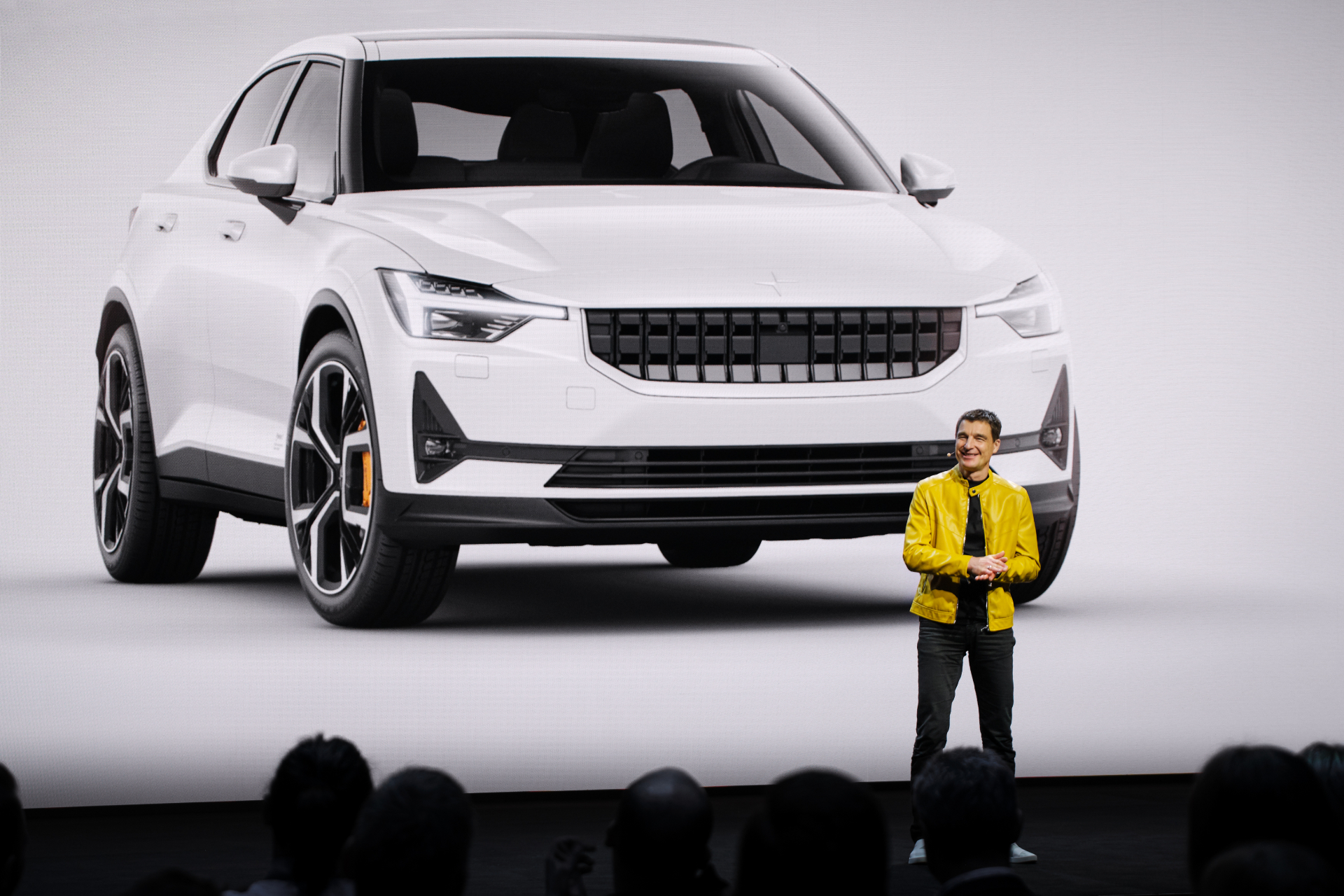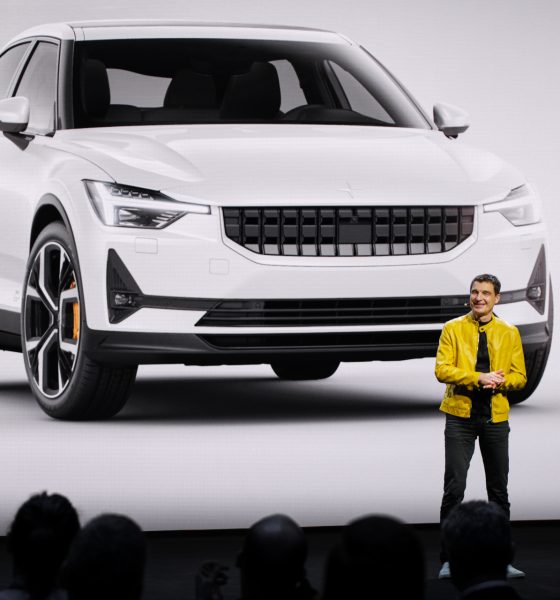

News
Volvo seals twin battery supply deal to ramp Tesla competitors like the Polestar 2
Volvo has signed a multi-billion dollar supply deal with two major battery manufacturers in an effort to ramp its electric vehicle transition efforts.
The Swedish luxury vehicle company has contracted with China-based CATL (Contemporary Amperex Technology Co Ltd) and LG Chem in Korea to supply the lithium-ion batteries for its upcoming electric vehicle (EV) fleets under both its own brand and under its Polestar joint venture with Geely. Volvo expects 50% of its global sales volume to comprise electric vehicles by 2025, and this latest deal is a nod towards that bigger picture.
LG Chem already supplies batteries to most of the world’s largest car brands, including Volkswagen, Mercedes, and Renault, and it plans to increase its current production capacity to 100 GWh per year by 2020 in order to meet the growing demand driven by EV developments. CATL, on the other hand, is already China’s biggest EV battery manufacturer and its newest factory is aiming for a 25 GWh per year production capacity. In contrast, Tesla’s Gigafactory 1 in Sparks, Nevada has already reached 35 GWh capacity with its Japanese battery supply partner Panasonic, albeit that level is still theoretical. The actual output is around 24 GWh annually.

Tesla’s relationship with Panasonic is different than the traditional supplier relationship other car makers have with their battery manufacturers, namely in that they are partners. This way, Tesla has a reliable supply of batteries to manufacture its vehicles, and Panasonic has a guaranteed buyer. When battery supply and the car production rates are matched, both companies experience a win-win situation, and they can work together effectively to ensure that best outcome for both parties. Panasonic currently produces the 18650 battery cells used in the Model S and Model X and the 21700 cells utilized in the Model 3.
Volvo’s decision to transform Polestar into a high-performance, stand-alone brand came in 2017, and the launch of the all-electric Polestar 2 fastback in February this year officially put the company in the running as a direct Tesla Model 3 competitor. The Polestar 2 is equipped with dual motors which produce over 400 hp and power the car from 0-60 mph in under 5 seconds. However, this doesn’t quite match up to the Model 3 Performance’s 450 hp and 0-60 time of 3.2 seconds at the same price point – both cars are offered for around $60,000.
Tesla’s battery ranges also increased significantly for all new vehicles since the Polestar 2 unveiling, which means more innovation in battery efficiency will be in order if Volvo and Geely truly want to compete against the Model 3. Polestar’s 78 kWh battery is estimated to have a 275 mile range while the Model 3 Performance is rated for 310 miles of range. That particular variation might not be where Polestar has the most competition, though. The Model 3 Long Range keeps the 310 mile range, has a 0-60 mph time of 4.4 seconds, and has a price point of about $50,000, all stats which outperform Polestar 2’s announced capabilities for a much lower cost to consumers.
Overall, however, Volvo’s new deal with LG Chem and CATL indicates that the company is serious about electrifying its fleet, and competition is good for innovation all around. Polestar 2 is set to begin production in 2020.

Elon Musk
Elon Musk and Tesla AI Director share insights after empty driver seat Robotaxi rides
The executives’ unoccupied tests hint at the rapid progress of Tesla’s unsupervised Robotaxi efforts.

Tesla CEO Elon Musk and AI Director Ashok Elluswamy celebrated Christmas Eve by sharing personal experiences with Robotaxi vehicles that had no safety monitor or occupant in the driver’s seat. Musk described the system’s “perfect driving” around Austin, while Elluswamy posted video from the back seat, calling it “an amazing experience.”
The executives’ unoccupied tests hint at the rapid progress of Tesla’s unsupervised Robotaxi efforts.
Elon and Ashok’s firsthand Robotaxi insights
Prior to Musk and the Tesla AI Director’s posts, sightings of unmanned Teslas navigating public roads were widely shared on social media. One such vehicle was spotted in Austin, Texas, which Elon Musk acknowleged by stating that “Testing is underway with no occupants in the car.”
Based on his Christmas Eve post, Musk seemed to have tested an unmanned Tesla himself. “A Tesla with no safety monitor in the car and me sitting in the passenger seat took me all around Austin on Sunday with perfect driving,” Musk wrote in his post.
Elluswamy responded with a 2-minute video showing himself in the rear of an unmanned Tesla. The video featured the vehicle’s empty front seats, as well as its smooth handling through real-world traffic. He captioned his video with the words, “It’s an amazing experience!”
Towards Unsupervised operations
During an xAI Hackathon earlier this month, Elon Musk mentioned that Tesla owed be removing Safety Monitors from its Robotaxis in Austin in just three weeks. “Unsupervised is pretty much solved at this point. So there will be Tesla Robotaxis operating in Austin with no one in them. Not even anyone in the passenger seat in about three weeks,” he said. Musk echoed similar estimates at the 2025 Annual Shareholder Meeting and the Q3 2025 earnings call.
Considering the insights that were posted Musk and Elluswamy, it does appear that Tesla is working hard towards operating its Robotaxis with no safety monitors. This is quite impressive considering that the service was launched just earlier this year.
Elon Musk
Starlink passes 9 million active customers just weeks after hitting 8 million
The milestone highlights the accelerating growth of Starlink, which has now been adding over 20,000 new users per day.

SpaceX’s Starlink satellite internet service has continued its rapid global expansion, surpassing 9 million active customers just weeks after crossing the 8 million mark.
The milestone highlights the accelerating growth of Starlink, which has now been adding over 20,000 new users per day.
9 million customers
In a post on X, SpaceX stated that Starlink now serves over 9 million active users across 155 countries, territories, and markets. The company reached 8 million customers in early November, meaning it added roughly 1 million subscribers in under seven weeks, or about 21,275 new users on average per day.
“Starlink is connecting more than 9M active customers with high-speed internet across 155 countries, territories, and many other markets,” Starlink wrote in a post on its official X account. SpaceX President Gwynne Shotwell also celebrated the milestone on X. “A huge thank you to all of our customers and congrats to the Starlink team for such an incredible product,” she wrote.
That growth rate reflects both rising demand for broadband in underserved regions and Starlink’s expanding satellite constellation, which now includes more than 9,000 low-Earth-orbit satellites designed to deliver high-speed, low-latency internet worldwide.
Starlink’s momentum
Starlink’s momentum has been building up. SpaceX reported 4.6 million Starlink customers in December 2024, followed by 7 million by August 2025, and 8 million customers in November. Independent data also suggests Starlink usage is rising sharply, with Cloudflare reporting that global web traffic from Starlink users more than doubled in 2025, as noted in an Insider report.
Starlink’s momentum is increasingly tied to SpaceX’s broader financial outlook. Elon Musk has said the satellite network is “by far” the company’s largest revenue driver, and reports suggest SpaceX may be positioning itself for an initial public offering as soon as next year, with valuations estimated as high as $1.5 trillion. Musk has also suggested in the past that Starlink could have its own IPO in the future.
News
NVIDIA Director of Robotics: Tesla FSD v14 is the first AI to pass the “Physical Turing Test”
After testing FSD v14, Fan stated that his experience with FSD felt magical at first, but it soon started to feel like a routine.

NVIDIA Director of Robotics Jim Fan has praised Tesla’s Full Self-Driving (Supervised) v14 as the first AI to pass what he described as a “Physical Turing Test.”
After testing FSD v14, Fan stated that his experience with FSD felt magical at first, but it soon started to feel like a routine. And just like smartphones today, removing it now would “actively hurt.”
Jim Fan’s hands-on FSD v14 impressions
Fan, a leading researcher in embodied AI who is currently solving Physical AI at NVIDIA and spearheading the company’s Project GR00T initiative, noted that he actually was late to the Tesla game. He was, however, one of the first to try out FSD v14.
“I was very late to own a Tesla but among the earliest to try out FSD v14. It’s perhaps the first time I experience an AI that passes the Physical Turing Test: after a long day at work, you press a button, lay back, and couldn’t tell if a neural net or a human drove you home,” Fan wrote in a post on X.
Fan added: “Despite knowing exactly how robot learning works, I still find it magical watching the steering wheel turn by itself. First it feels surreal, next it becomes routine. Then, like the smartphone, taking it away actively hurts. This is how humanity gets rewired and glued to god-like technologies.”
The Physical Turing Test
The original Turing Test was conceived by Alan Turing in 1950, and it was aimed at determining if a machine could exhibit behavior that is equivalent to or indistinguishable from a human. By focusing on text-based conversations, the original Turing Test set a high bar for natural language processing and machine learning.
This test has been passed by today’s large language models. However, the capability to converse in a humanlike manner is a completely different challenge from performing real-world problem-solving or physical interactions. Thus, Fan introduced the Physical Turing Test, which challenges AI systems to demonstrate intelligence through physical actions.
Based on Fan’s comments, Tesla has demonstrated these intelligent physical actions with FSD v14. Elon Musk agreed with the NVIDIA executive, stating in a post on X that with FSD v14, “you can sense the sentience maturing.” Musk also praised Tesla AI, calling it the best “real-world AI” today.








